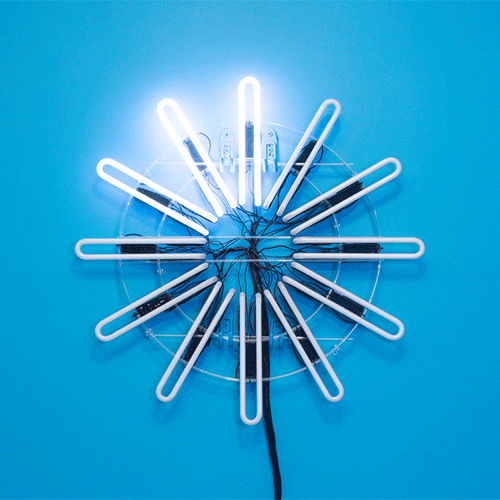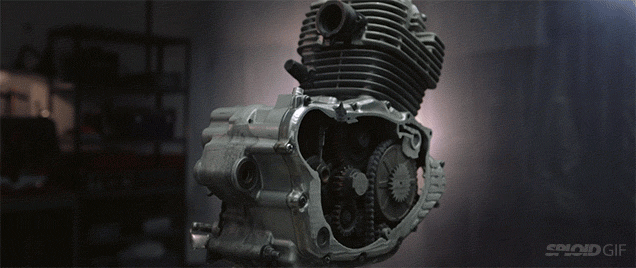
Ein fantastischer Wandschmuck von Clayton Boyer, der, wenn man ihn ins Laufen bringt, verdammt trippy daherkommt. Würde ich mir in die Wohnstube hängen.
(Direktlink, via Dr. Eve Ell)

Ein fantastischer Wandschmuck von Clayton Boyer, der, wenn man ihn ins Laufen bringt, verdammt trippy daherkommt. Würde ich mir in die Wohnstube hängen.
(Direktlink, via Dr. Eve Ell)
Irgendwer hat in Hamburg-Wilhelmsburg eine Tür mit der Aufschrift „Refugees Welcome“ in den Zaun gebaut, der das ehemalige Freihafengebiet Richtung Spreehafen abgrenzt. Das hat praktisch keine Auswirkungen, da der Zaun keine echte Grenzfunktion hat und irgendwie nur Zollgebiete trennen soll. Aber die Symbolik ist enorm.
Gefunden und fotografiert hat die Tür Nils Waldow von Strassenfotografie.
Refugees Welcome! (mein Lieblingsfoto 2015)
Posted by Straßenfotografie on Donnerstag, 10. September 2015
(via Urbanshit)
5 KommentareMir erschließt sich nicht genau, was hier gemacht wird, vermute aber, dass die mit irgendwelchen Kunstharzen eine Fußbodengestaltung praktizieren, die quasi völlig neue Möglichkeiten eröffnet. Wohl auch in 3D-Optik. Schon irgendwie geil, auch wenn mein bevorzugtes Motiv hier jetzt nicht bei ist und das Video auch durchaus hätte etwas schöner sein können.
Pintura de Piso artístico em 3D
Quer pintar sua casa ??
Excellence Pinturas, desenvolve com exelencia acabamentos para paredes que reproduzem a necessidade estética de todo e qualquer arquiteto, designer ou pintor.Posted by Universidade da Pintura on Sonntag, 30. August 2015
Im Rahmen der Ruhr Triennale hat das Atelier Van Lieshout eine Installation mit dem Namen „The Good, the Bad and the Ugly“ vor die Jahrhunderthalle gebaut. Dabei ist z.B. ein begehbares Arschloch inklusive Darm. Außerdem wurden Bungalowähnliche Behausungen gebaut. So wie diese hier unten. Sie trägt den Namen „Domestikator“ und sieht irgendwie ganz besonders schön aus.
„The Good, the Bad and the Ugly“ ist die größte Installation, die bisher von Atelier Van Lieshout realisiert wurde. Im Zentrum steht eine Gebäudeskulptur, das „Refektorium“, Spielort der Ruhrtriennale, wo u.a. die Werkstattgespräche stattfinden. Umgeben ist das „Refektorium“ von neuen Arbeiten aus dem Atelier Van Lieshout wie dem „Domestikator“ und ikonografischen Arbeiten wie der „BarRectum“, dem „Workshop for Weapons and Bombs“, dem „Workshop for Medicine and Alcohol“ und schlussendlich „The Heads, Claudia & Hermann“. Darüber hinaus werden datschaähnliche Behausungen wie „Caretaker“, „Domestikator“ und „Farmhouse“ die Großinstallation auf dem Gelände der Jahrhunderthalle Bochum vervollständigen.
 Einen Kommentar hinterlassen
Einen Kommentar hinterlassen „Gyroscopic Illuminated Figure (GIF) takes a symbol of anticipation, frustration, and promise and extends it indefinitely.“

(via this isn’t happiness)
Thomas Blanchard experimentiert für „The Colors of Feelings“ mit Farbe, Milch, Honig, Öl und Zimt – und schafft damit den vielleicht schönsten Bildschirmschoner der Welt. Dazu gibt es Musik von Max Richter. Passt.
„The Colors of Feelings“ is an experimental dreamlike video rocking us smoothly through circular moves. It is also an analogy of feelings such as anger, love, sadness and joy ; they mix and eventually ease.
https://vimeo.com/135960434
(Direktlink, via Laughing Squid)
Sieht man auch nicht alle Tage.

„This stop motion video of a bike engine being sanded down one inch at a time is a great reminder that destruction can be beautifull too.“
https://youtu.be/5CqeOXqtNxk
(Direktlink, via Like Cool)
Diese Installation von Martin Backes wirkt ein wenig so als würde ein Computer Karaoke singen. Und wenn man es nicht ganz so genau nimmt, klingt das auch so. Aber diese Balladen der 90er sind allesamt ohnehin keine akustischen Schönheiten.
„What do machines sing of?“ is a fully automated machine, which endlessly sings number-one ballads from the 1990s. As the computer program performs these emotionally loaded songs, it attempts to apply the appropriate human sentiments. This behavior of the device seems to reflect a desire, on the part of the machine, to become sophisticated enough to have its very own personality.
What do machines sing of? (90s Version)2015
Size: 170 x 55 x 45 cm
Material: metal stand, mic stand, mic, cable, 2 screens, computer, custom-made computer programList of songs which are included and performed by the computer program:
Whitney Houston – I Will Always Love You
R. Kelly – I Believe I Can Fly
Toni Braxton – Un-Break My Heart
Bryan Adams – Everything I Do, I Do It For You
Celine Dion – My Heart Will Go On
(Direktlink, via Create Digital Music)


Elliot Schultz bestickt für seine sich im liegen drehenden Zoetrope im 10″ Format, die ihre Schönheit dann auf einem sich drehenden Plattenspieler entfalten. Ich war in der Schule im Fach „Handarbeit fakultativ“ gar nicht mal so schlecht und mochte das Sticken sehr. Vielleicht wäre das ja im Alter ja noch mal was für mich.
Hier eine schöne Auswahl auf Behance.
„Inspired by the work of Alexandre Alexeieff and Claire Parker, I aimed to guide my production process indirectly through the limitations afforded by alternative media. Their invention, the pin screen, was used as the sole medium in the production of six short films, and shaped the outcome of their work. In response, I have designed and embroidered animated sequences onto discs, similar to the Phenakistokope, Zoopraxiscope and Stamfer Disc layouts. This repurposing of media introduced strict parameters, namely spatial, tonal and temporal, and has greatly informed all stages of my process.“
(Direktlink, via Colossal)

Hübsches Design-Experiment vom Copenhagen Institute of Interaction Design für das leitfähige Farbe auf Papier gemalt wird, wodurch sich Sound-Loops spielen lassen.
Conductive paint and resistive graphite were used to draw functioning circuits on paper discs. When the synthesizer completes the circuit its pitch is changed by the varying resistance of the graphite strips.
(Direktlink, via Tasmo)